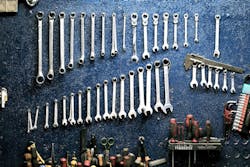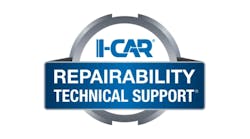As a second-generation owner of Cope Collision Center, Rick Cope is well aware of what his everyday customer looks like—and for him, it’s a mix of every type of person in the town of Meridian, Idaho.
“We’ve been in business for so long, we’re a staple of the community,” Cope says.
Cope took over his business from his father, Gerald, and, now, both his daughter and son also work in the business. While his daughter runs the front office, his son focuses on parts-checking, mirror-matching and more shop floor processes.
But, with a wide variety of customers coming into the shop, the staff had to adapt to the needs of its customer base and learn how to best communicate with and serve each person. The shop today receives a chunk of its customer base from people noticing Google reviews and ratings online.
Overall, the shop produces $2 million annually and, on average, sees 65 cars come through the shop in one month.
The shop strives to stay at the top of its game with its customers’ feedback, reviews and ratings, Cope says, yet the process to get to positive online reviews came with its own learning curve.
The Backstory
Gerald Cope opened Cope Auto Repair in 1963 and Rick Cope grew up in his dad’s business. The younger Cope went on to attend the state’s collision repair vocational program. Cope and his father switched over to do more collision repair—changing the name to Cope Collision Center with it—in 1982 due to changes in the mechanical space.
Cope changed the name in an effort to better communicate the shop’s goal of delivering quality collision repairs to customers.
Today, Cope continues to strive to communicate and provide the customer with the best possible vehicle repair. And, it’s paying off; right now, the shop’s average review rating on sites like Carwise is 4.8, he says.
The Problem
Roughly 8–10 years ago, Cope joined a 20 Group and quickly realized that some customer communication improvements were needed in Meridian. His shop has been a staple in the area with most customers coming in because they know its long history or have been referred to the shop.
But, Cope eventually realized that, even though customers were being referred, the newer generations of customers experience service in different ways because of the technology available at their fingertips.
This was right as texting was becoming more popular, Cope says, and the shop was starting to see that not every customer wanted to be contacted via a traditional phone call. Instead, customers were starting to text more and more.
Cope’s shop was also garnering a less-than-ideal score when it came to online reviews. The shop’s average for customer reviews was 4.5, he says.
The shop staff needed to find a way to show they knew how their customer base was evolving and how to stay on top of that trend.
The Solution
Some older clients still want to be notified of repairs through a phone call, Cope says. Most of the customers coming through the shop are working adults in their 30s to 40s, even though the shop does do repairs for some high school students.
Many others, though, want to be notified by text.
Cope discovered his customers’ preferences by asking every single person through the door, in what manner they’d prefer to be communicated. This is a 10–15 minute process, which might be a little longer if there are insurance companies involved. Typically, their customers prefer to be texted and that’s noted through the shop’s CCC UpdatePromise system. After a customer’s information is updated in the system, the customer will be sent a link to fill out a survey.
So, Cope and his staff started by using the CCC system. They started using UpdatePromise, which has the customer leave a review on Carwise. Then, almost a year ago, they added on another service called Podium, a platform that gives customers options on messaging and customer interaction, on a trial basis.
The process was smooth and the staff came on board to the change quickly, he says. After adding the software to the website so a little icon pops up in the corner that greets the customer and prompts him or her to utilize the tool to text the shop with any questions. The shop receives a text message from the customer and then the employee has the option to reply with his or her name and ask how he or she can help the customer. The messages can be accessed by any team member and they never expire in the Podium system.
Now, the staff updates clients every day because they feel it’s important to keep them aware of changes in the vehicle, such as additional damages that might have been found in the supplement, or if the team needs to order another part.
“We find that once they understand what’s happening with the vehicle, the customer wants to make sure it gets fixed,” Cope says.
The shop’s employees found that, even if they’re updating the customer that nothing additional was found on their car, it’s better than receiving no updates.
Through the Podium service, the shop was also able to increase its Google reviews. Now, for sites like Carwise, the shop averages a 4.8 and for Google, the shop has a 4.9 score.
The team also tries to re-evaluate the process periodically to make sure they stay up to date with what a customer prefers.
The Aftermath
Since switching the process, the shop’s online review score has not dropped below 4.8. And Cope attributes that to the fact that his daughter, Danielle Thorp, makes sure to watch and monitor reviews daily.
Thorp will respond to customer surveys and reviews every morning, she says.
“Even if it’s on a Friday night or Saturday morning, I respond to them as soon as I get them,” she says. “This way it lets them know we appreciate them.”
When it comes to customer updates, every day, no matter what time it is, the staff doesn’t leave the shop until the customer is updated on their repair.
The Takeaway
Since focusing more on their customer’s opinions in the repair process, Danielle has taken over control of the front office and managing the customer interactions.
Thorp says that she has seen the best results from customers when she or another employee take the time to respond instead of outsourcing the responsibility to another company. For example, she tried paying Optimum Automotive to respond to all of them but thought the result simply wasn’t personal enough.
“I like to personally respond to them because I have that one-on-one interaction with people and I can speak to conversations we had, or this and that, in those responses,” Thorp says.
SHOP STATS: Cope Collision Center Location: Meridian, Idaho. Operator: Rick Cope Average Monthly Car Count: 65 Staff Size: 11 (4 office workers, 7 in the shop, including 2 in the paint side/detailer/parts person/2 body men Shop Size: 12,500 square feet; Annual Revenue;$2 million



